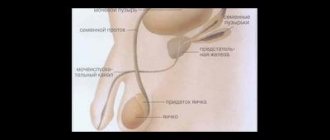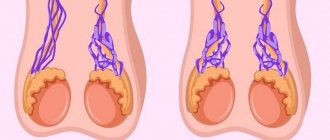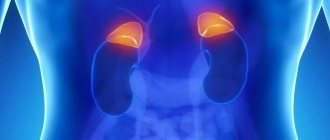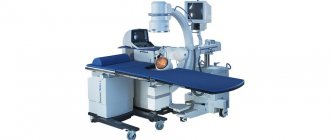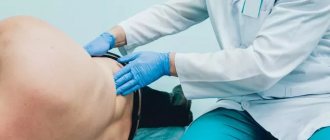What is a disease?
The disease is a pathological dilatation of the veins of the spermatic cord. In most clinical cases, the disease passes without severe symptoms and is detected only during a routine examination. There are several classifications of the disease based on the nature of changes in the organ. At the moment, only one, proposed by the World Health Organization, is actively used. According to this classification, there are three degrees of the disease.
- The first is diagnosed by the expansion of the venous plexuses, their protrusion through the skin of the scrotum, and their palpation.
- We can confidently speak about the second degree even if the dilated vessels are not visible, but they can be felt.
- Third-degree varicocele is characterized by the absence of visual manifestations and changes during palpation. The disease can only be diagnosed after performing the Valsalva maneuver.
How to cure varicocele
Unfortunately, treatment of varicocele without surgery is not currently available. If somewhere you hear about effective methods of combating a disease using non-surgical methods, you should not trust such proposals. The only way to get rid of dilated veins is surgery. But the operation is carried out only according to indications:
- if the man still plans to have children;
- there is severe pain in the groin and scrotum;
- venous plexuses are visible to the naked eye;
- there is deterioration in the spermogram;
- there is infertility.
If we consider how surgery is performed for varicocele, then with any intervention the goal is to stop blood flow through the dilated vein. To do this, it is bandaged, crossed or removed. The most effective operations for varicocele:
- classical operation according to Ivanisevich;
- microsurgical testicular revascularization;
- endoscopic intervention;
- Operation Marmara.
At the clinic Dr. AkNer uses the most modern and safe treatment methods and low-traumatic operations that have a short recovery period. In the case of varicose veins of the spermatic cord, it is important not to start the process and to be examined in time to determine treatment tactics. Therefore, do not delay your visit to the urologist. You can make an appointment at any convenient time by writing to us in the contact form on the website or calling 8 (495) 098-03-03 or.
Causes of varicocele of the 3rd degree
The etiology of grade 3 varicocele in men is different, which is why it needs to be studied in detail. The following factors are considered to be the causes of the disease.
- Weak vascular wall. The disease has a genetic predisposition. During a detailed diagnosis, dilated veins of the extremities, defects of the heart valves and other malformations of connective tissue are found in the patient’s male relatives.
- Increased pressure in the scrotum and pelvis. Changes in anatomy inevitably lead to changes in the vascular bed, which becomes the basis for the development of the disease. The testicular vein can be compressed, for example, by neoplasms, impeding the reverse flow of blood from the organ. Rarely, increased pressure is associated with systemic phenomena, such as diarrhea or constipation, tension in the abdominal muscles.
Varicocele - symptoms and treatment
Treatment of varicocele is only surgical; no other treatment methods, including lifestyle adjustments and medications, are effective.
Surgical treatment of varicocele is indicated in the presence of:
- pain in the scrotum;
- testicular hypotrophy;
- male infertility.
Over the entire history of varicocele treatment, more than 300 different surgical procedures have been proposed.
Today four types of operations are used:
- Ivanissevich operation;
- laparoscopic venectomy;
- X-ray endovascular occlusion of the testicular vein.
- microsurgical subinguinal varicocelectomy
All presented treatment methods are aimed at blocking the reverse flow of venous blood through the most effective intersection of the testicular veins at different levels.
Ivanissevich's operation is the simplest and least effective method of treating varicocele. An incision is made in the iliac region on the left, the testicular vein, represented by one or two or three trunks, is located in the retroperitoneal space, ligated and intersected. The advantages of the operation are ease of execution; disadvantages - high trauma, poor cosmetic result (incision 5-7 cm) and a very high frequency of complications, for example, relapse of varicocele (recurrence of varicocele) - 29% and hydrocele (dropsy, accumulation of a large amount of fluid between the membranes of the scrotum, increasing its volume and requiring surgical treatment) - 5-10%.[8]
Laparoscopic venectomy differs from the Ivanissevich procedure in that an endoscopic technique is used to access the testicular vein. Small incisions (3 x 1.5 cm) are made on the anterior surface of the abdomen, through which a camera and endoscopic instruments are inserted into the abdominal cavity, with the help of which the testicular vein is located, isolated, clipped and intersected. The advantages of this technique include a better cosmetic effect compared to the Ivanissevich operation. The disadvantages are a fairly high risk of relapse (7%) and hydrocele (5.8%), as well as the possibility of developing severe complications associated with penetration into the abdominal cavity (intestinal injury, large vessels and nerves, pulmonary embolism, peritonitis, postoperative pain in the right shoulder (due to diaphragmatic distension during pneumoperitoneum).[8]
Endovascular testicular vein embolization is an operation performed not by urologists, but by vascular surgeons. Under local anesthesia, a small incision is made in the thigh to access the venous system. After which a catheter is inserted into the vein and passed first into the renal and then into the testicular vein. Along the entire length of the testicular vein, obstacles to the flow of blood are placed in the form of spirals. The advantages of this technique are that it is less traumatic, the procedure is performed under local anesthesia, and there is no risk of complications such as hydrocele. The fact is that the cause of hydrocele is accidental ligation of the lymphatic vessels through which interstitial fluid moves. This operation is performed from the lumen of the vein, which eliminates damage to the lymphatic vessels and, accordingly, the development of hydrocele. The disadvantages include radiation exposure (the operation is performed under X-ray control), a high rate of unsuccessful interventions - 9-27%, i.e. situations where the surgeon, due to anatomical features, is unable to reach the testicular vein, there is a high rate of relapses - 10% and other complications - 11% (hematomas, perforations, bleeding). Today this technique is not used as a method of primary treatment of varicocele; it can be used for relapse when other operations have failed.
Microsurgical subinguinal varicocelectomy (Marmara procedure) is the “gold standard” for surgical treatment of varicocele. With this technique, a 2-2.5 cm incision is made at a level just above the base of the penis. Access is provided to the spermatic cord, which is isolated from the surrounding tissues and removed into the wound. Next, under optical magnification, the spermatic funiculus is opened and its vessels are divided, while the veins are ligated, and the artery and lymphatic vessels must be preserved.
The advantages of the technique include low trauma, good cosmetic results, low probability of relapse - 1% and hydrocele - 0.4%. The disadvantages are the complexity of the procedure, requiring lengthy training, and the dependence of the result on the experience of the surgeon (it is necessary to perform at least 100 such operations per year to ensure an optimal result), as well as a violation of the arterial blood supply to the testicle in case of damage to the testicular artery, which is extremely rare (less 0.01% of cases).[8]
Main signs of the disease
To answer the question of how the disease manifests itself, it is necessary to find out what happens with grade 3 varicocele. Impaired blood supply due to the factors listed above leads to the fact that testicular tissue is insufficiently oxygenated. Dilated veins increase the temperature of the adjacent organ and, as a result, inhibit its function. It is these processes that lead to the manifestation of the disease. Symptoms of grade 3 varicocele are pain that does not stop even in a supine position. The asymmetry of organs, as well as changes in their structure, are visually determined. The disease is often accompanied by sexual dysfunction and difficulty urinating.
Symptoms of varicocele
Due to dilated veins, the functioning of the testicle on the affected side is disrupted. Most often, the disease occurs in one of two forms: either pain and discomfort in the testicles, or infertility. 50% of men experience no symptoms at all, 25% experience discomfort, and another 25% develop infertility. Moreover, this is typical for all stages of the disease.
From here we can distinguish the following symptoms of varicocele:
- Pain in the testicle of a pulling, pressing nature. Patients describe it as heaviness in the testicle. It is observed not constantly, but periodically: after physical exertion, thermal procedures, sexual intercourse, or prolonged sitting.
- Enlarged veins Depending on the degree of expansion, they can be felt while standing or lying down, and at the last stage they can be seen even without palpation.
- Enlargement of the scrotum. Due to the dilated veins, it increases in size, and on the affected side it also sinks significantly more.
Military service with illness
Often, men of military age are asked whether they are allowed into the army with grade 3 varicocele. Since the disease is serious, accompanied by severe pain and requires prompt treatment, patients are not fit for service. With this diagnosis, conscripts do not receive an unambiguous removal from the army, but are only released from military duties for a while. The medical board doctors issue recommendations for surgical intervention, which is carried out at the discretion of the patient. After surgery, grade 3 varicocele may be drafted into the army.
Diagnosis of the disease
To detect stage 3 left varicocele in men, Doppler ultrasound is used. The technique helps determine the intensity of blood flow in the testicle, the size of the organ and structural changes. Ultrasound is accompanied by a Valsalva maneuver, which consists of examining the veins of the organ with the body in an upright position.
Another way to make a diagnosis is a spermogram. It shows how well the testicle copes with its function. During the study, the following indicators are taken into account: quantity, consistency of sperm, its dilution, number of sperm and the percentage of mobile and dead cells.
Effective fight against pathology
If the patient is puzzled by the problem of how to treat grade 3 varicocele, then worries about therapy can be omitted. At the moment, the pathology is successfully removed surgically. There is no conservative therapy because medications do not give the desired effect. Before prescribing surgery, the doctor takes into account several factors. First of all, test data, the patient’s age, his condition at the time of treatment. If the operation does not make sense, then the doctor refuses this measure. But often intervention is still prescribed, since infertility with grade 3 varicocele is considered the most undesirable consequence.
The essence of surgical treatment
The question of how surgery is performed for grade 3 varicocele worries more than one patient. With this diagnosis, intervention, the price of which depends on the presence of concomitant diseases, is performed by laparoscopy. Ligation of the testicular veins is performed in two or three punctures. The procedure lasts relatively short, after which the patient remains in the hospital for several days. After surgery for grade 3 varicocele, physical activity and sports are prohibited for some time.
Treatment methods for grade 3 varicocele
Effective treatment of grade 3 varicocele is only possible through surgery. In modern urology, several surgical techniques are used.
- According to Ivanissevich, the pathologically dilated vein is ligated or removed through an incision in the groin.
- Endoscopic - based on sclerosis of the affected vessels using an endoscope.
- According to Marmar, vein ligation is carried out through a minimal incision at the base of the penis.
The most effective of them is microsurgical Marmara varicocelectomy. The advantages of this method of treating grade 3 varicocele:
- low likelihood of complications and relapse,
- possibility of using local anesthesia,
- low tissue trauma,
- short duration of the operation - about 20-30 minutes,
- fast recovery.
To treat grade 3 varicocele, specialists at our andrology clinic in Moscow use advanced techniques. Make an appointment in advance by calling the number listed on the website.


